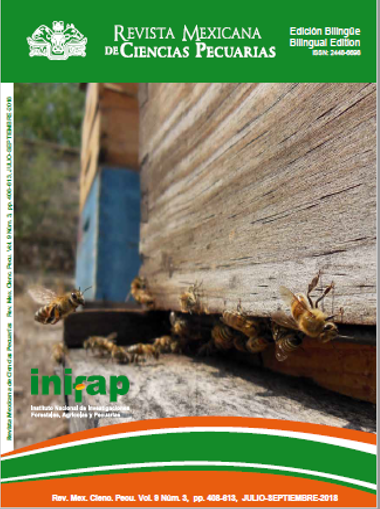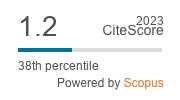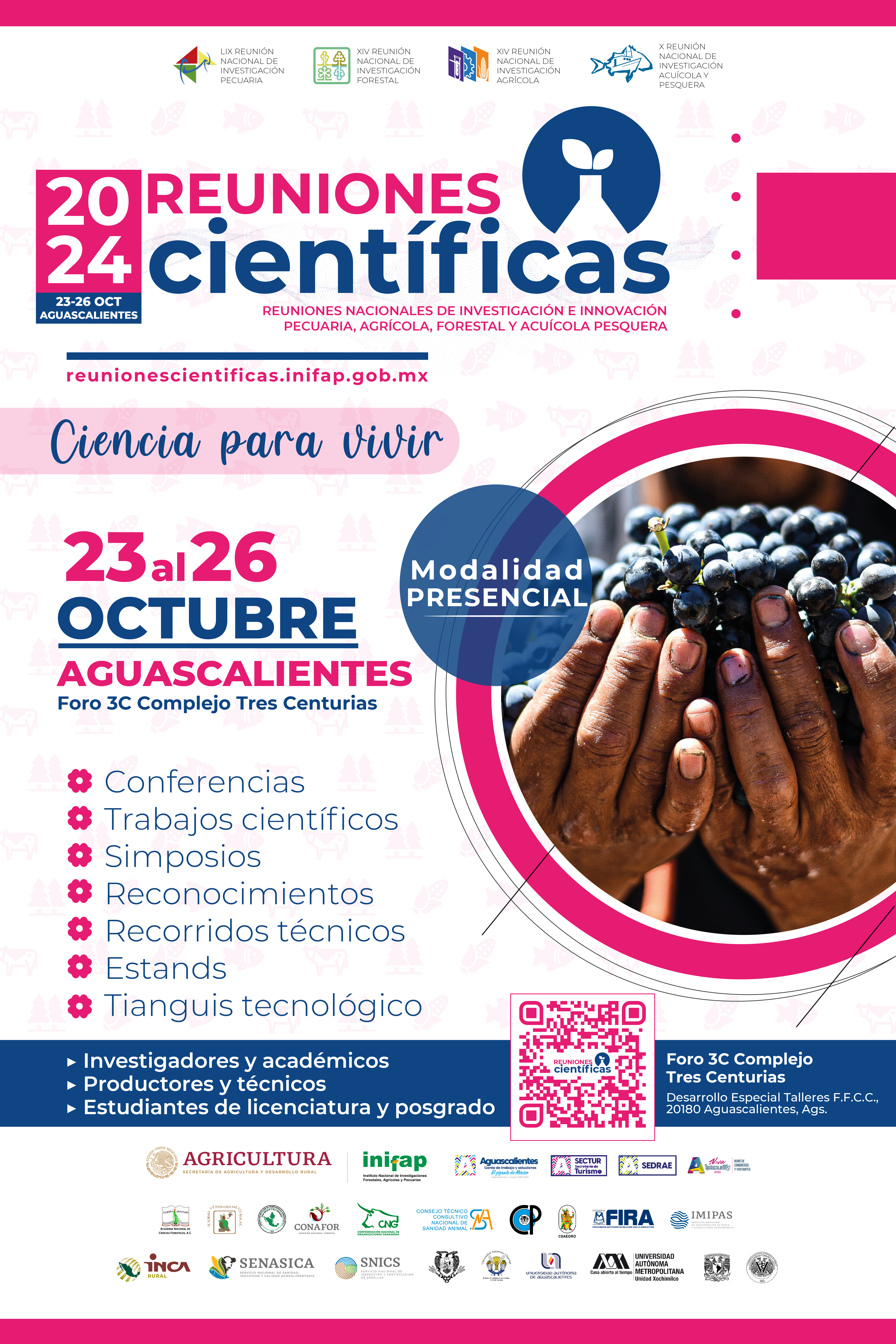Metales pesados en leche de vacas alimentadas con alfalfa producida en suelos irrigados con aguas residuales en Puebla y Tlaxcala, México
DOI:
https://doi.org/10.22319/rmcp.v9i3.4358Palabras clave:
Bioacumulación, Translocación, Metales pesados, Contaminación alimentaria, Leche.Resumen
El objetivo fue determinar la presencia de Cd, Pb, Ni, Cu, Cr, Zn y As en la cadena alimentaria de la leche de vaca, producida en zonas donde la alfalfa es cultivada en suelos irrigados con aguas residuales de procedencia industrial, doméstica y agrícola. Se muestrearon suelo y alfalfa de 16 sitios ubicados en cuatro zonas; la leche se colectó de 160 vacas, correspondiendo a 40 vacas de cuatro hatos diferentes por zona, todo en dos épocas del año y por triplicado. Se calculó el factor de bioacumulación (BCF), el factor de translocación (TF) y el valor de transferencia de los metales de la planta a la leche. Las plantas tuvieron un BCF <1, indicando que la alfalfa es resistente a los metales pesados. Sin embargo, el TF >1 en orden decreciente quedó de la siguiente manera: Zn; Cu; Ni; Pb y Cr, lo que muestra la existencia de gran movilidad de los metales dentro de la planta. La leche tuvo un contenido de Pb en un rango de 0.039 ± 0.02 a 0.059 ± 0.05 mg kg-1, valores por arriba del límite internacional permitido. Sin embargo, los niveles de Pb y As fueron inferiores a los valores permisibles por la Norma Oficial Mexicana. Se concluye que la alfalfa es una planta acumuladora y resistente a los metales pesados, y cuando es cultivada en suelos contaminados, se convierte en un medio importante para la trasferencia de metales pesados a los animales y son eliminados a través de la leche.
Descargas
Citas
Haiyan W, Stuanes AO. Heavy metal pollution in air-water-soil-plant system of Zhuzhou city, Hunan province, China. Water Air Soil Pollut 2003;147:79–107.
Chang CY, Yu HY, Chen JJ, Li FB, Zhang HH, Liu CP. Accumulation of heavy metals in leaf vegetables from agricultural soils and associated potential health risks in the Pearl River Delta, South China. Environ Monit Assess 2014;186:1547–1560.
Bortey-sam N, Nakayama SMM, Ikenaka Y, Akoto O, Baidoo E, Beyene Y, et al. Human health risks from metals and metalloid via consumption of food animals near gold mines in Tarkwa, Ghana : Estimation of the daily intakes and target hazard quotients (THQs). Ecotoxicol Environ Saf 2015;111:160–167.
Sundberg J, Ersson B, Lönnerdal B, Oskarsson A. Protein binding of mercury in milk and plasma from mice and man - A comparison between methylmercury and inorganic mercury. Toxicol Appl Pharmacol 1999;137:169–184.
Dorea JG, Donangelo CM. Early (in uterus and infant) exposure to mercury and lead. Clin Nutr 2006;25:369–376.
ATSDR. The Agency for Toxic Substances and Disease Registry, Atlanta, GA. http://www.atsdr.cdc.gov/, 2013. Accessed Sept 29, 2015.
Gulson BL, Mizon KJ, Korsch MJ, Howarth D. Non-orebody sources are significant contributors to blood lead of some children with low to moderate lead exposure in a major lead mining community. Sci Total Environ 1996;181(3):223–230.
Muchuweti M, Birkett JW, Chinyanga E, Zvauya R, Scrimshaw MD, Lester JN. Heavy metal content of vegetables irrigated with mixtures of wastewater and sewage sludge in Zimbabwe: Implications for human health. Agric Ecosyst Environ 2006;112(1):41–48.
Duruibe JO, Ogwuegbu MOC, Egwurugwu JN. Heavy metal pollution and human biotoxic effects. Int J Phys Sci 2007;2(5):112–118.
Hamdi H, Benzarti S, Aoyama I, Jedidi N. Rehabilitation of degraded soils containing aged PAHs based on phytoremediation with alfalfa (Medicago sativa L.). Int Biodeterior Biodegrad 2012;67:40–47.
Chen F, Wang S, Mou S, Azimuddin I, Zhang D, Pan X, et al. Physiological responses and accumulation of heavy metals and arsenic of Medicago sativa L. growing on acidic copper mine tailings in arid lands, J Geochemical Explor 2015;157:27–35.
Bernal Martínez LR, Rojas-Garduño MA, Vázquez-Fontes C, Espinoza-Ortega A, Estrada-Flores J, Castelán-Ortega OA. Determinación de la calidad fisicoquímica de la Revista leche cruda producida en sistemas campesinos en dos regiones del Estado de México. Vet Méx 2007;38:395-407.
Rayas-Amor A, Estrada-Flores JG, Mould FL, Castelán-Ortega OA. Nutritional value of forage species from the Central highlands region of Mexico at different stages of maturity. C Rural, Santa María 2012;42 (4):705-712.
SIAP, Servicio de Información Agroalimentaria y Pesquera. Resumen nacional de ganadería. http://www.siap.gob.mx/index.php?option=com. Consultado May 29, 2016.
INEGI, Instituto Nacional de Estadística y Geografía. Información nacional por entidad federativa y municipios. http://www.3.inegi.org.mx/sistemas/mexicocifras/default. aspx?e=21. Consultado May 29, 2016.
Esmaeili A, Moore F, Keshavarzi B, Jaafarzadeh N, Kermani M. A geochemical survey of heavy metals in agricultural and background soils of the Isfahan industrial zone, Iran. Catena 2014;121:88–98.
Norma Oficial Mexicana NOM-021-SEMARNAT-2000. El establecimiento de las especificaciones de la fertilidad, salinidad y clasificación de suelos estudio, toma de muestras y análisis. Secretaría de Medio Ambiente y Recursos Naturales. Diario Oficial de la Federación. http://biblioteca.semarnat.gob.mx/janium/Documentos/Ciga/libros 2009/ DO2280n.pdf, 2002 Consultado Nov 12, 2015.
Bao Z, Wu W, Liu H, Chen H, Yin S. Impact of long-term irrigation with sewage on heavy metals in soils, crops, and groundwater. A case study in Beijing. Polish J Environ Stud 2014;23(2):309–318.
Wang Y, Qiao M, Liu Y, Zhu Y. Health risk assessment of heavy metals in soils and vegetables from wastewater irrigated area, Beijing-Tianjin city cluster, China. J Environ Sci 2012;24(4):690–698.
Amin NU, Hussain A, Alamzeb S, Begum S. Accumulation of heavy metals in edible parts of vegetables irrigated with waste water and their daily intake to adults and children, District Mardan, Pakistan. Food Chem 2013;136(3–4):1515–1523.
Zayed A, Gowthaman S, Terry N. Phytoaccumulation of trace elements by wetland plants: I. Duckweed. J Environ Qual 1998;27(3):715–721.
Ghosh M, Singh SP. A comparative study of cadmium phytoextraction by accumulator and weed species. Environ Pollut 2005;133(2):365–371. doi:10.1016/j.envpol. 2004.05.015
Geyer H, Scheunert I, Korte F. Bioconcentration potential of organic environmental chemicals in humans. Regul Toxicol Pharmacol 1986;6(4):313–347.
Chamberlain AC. Fallout of lead and uptake by crops. Atmos Environ 1983;17(4):693-706.
Singh A, Sharma RK, Agrawal M, Marshall FM. Health risk assessment of heavy metals via dietary intake of foodstuffs from the wastewater irrigated site of a dry tropical area of India. Food Chem Toxicol 2010;48(2):611–619. doi:10.1016/j.fct.2009.11.041.
Chen L, Long X-H, Zhang Z-H, Zheng X-T, Rengel Z, Liu Z-P. Cadmium accumulation and translocation in two Jerusalem artichoke (Helianthus tuberosus L.) cultivars. Pedosphere 2011;21:573–580. doi:10.1016/S1002-0160(11)60159-8.
Majid NM, Islam MM, Abdul Rauf R, Ahmadpour P, Abdu A. Assessment of heavy metal uptake and translocation in Dyera costulata for phytoremediation of cadmium contaminated soil. Acta Agriculturae Scandinavica Section B - Soil Plant Sci 2011;62(3):245–250.
Xiong C, Zhang Y, Xu X, Lu Y, Ouyang B, Ye Z, et al. Lotus roots accumulate heavy metals independently from soil in main production regions of China. Sci Hortic 2013;164:295–302.
Galal TM, Shehata HS. Bioaccumulation and translocation of heavy metals by Plantago major L. grown in contaminated soils under the effect of traffic pollution. Ecol Indic 2015;48:244–251.
SAS Institute, SAS User’s Guide: Statistics Version 9.2. Statistical Analysis System Institute Cary, North Carolina, 2002; USA.
Stevens, Jeffrey B. Disposition of toxic metals in the agricultural food chain. Steady-state bovine milk biotransfer factors. Environ Sci Technol 1991;25:1289-1294.
Siebe C. Acumulación y disponibilidad de metales pesados en suelos regados con aguas residuales en el distrito de riego 03, Tula, Hidalgo, México. Rev Int Contam Ambient 1994;10:15–21. http://revistas.unam.mx/index.php/rica/article/view/30146. Consultado Nov 13, 2016.
Vázquez-Alarcón A, Justin-Cajuste L, Siebe-Grabach C, Alcántar-González G, De La Isla De Bauer MDL. Cadmio, níquel y plomo en agua residual, suelo y cultivos en el valle del Mezquital, Hidalgo, México. Agrociencia 2001;35:267–274.
CONAGUA, resúmenes mensuales de temperatura y lluvias. http://smn. conagua.gob.mx/ es/climatologia/ temperaturas-y-lluvias/resumenes-mensuales-de-temperaturas-y-lluvias. Consultado Oct 12, 2016.
Turer D, Maynard JB, Sansalone JJ. Heavy metal contamination in soils of urban highways: Comparison between runoff and soil concentrations at Cincinnati, Ohio. Water Air Soil Pollut 2001;132(3-4):293–314.
Kabata-Pendias A. Trace elements in soils and plants. Third ed. Boca Raton USA: CRC Press, Inc; 2000.
Peralta-Videa JR, Gardea-Torresdey JL, Walton J, Mackay WP, Duarte-Gardea M. Effects of zinc upon tolerance and heavy metal uptake in alfalfa plants (Medicago sativa). Bull Environ Contam Toxicol 2003;70(5):1036-1044.
Motesharezadeh B, Savaghebi-Firoozabadi GR. Bioaccumulation and phyto-translocation of nickel by Medicago sativa in a calcareous soil of Iran. Desert 2010;15(1):61–69. http://search.ebscohost.com/login.aspx?direct=true&db=s8h&AN= 54320222&site=ehost-live. Accessed Oct 23, 2016.
Kabata-Pendias A. Agricultural problems related to excessive trace element contents of soils. Salomons W, et al. editors. Heavy metals. Springer-Verlag Berlin Heidelberg 1995:3-18. http://link.springer.com/chapter/10.1007/978-3-642-79316-5_1. Accessed Jun 23, 2016.
McLaughlin MJ, Smolders E, Degryse F, Rietra R. Uptake of metals from soil into vegetables. Dealing with contaminated sites. Springer 2011;325-367.
Peralta-Videa JR, de la Rosa G, Gonzalez JH, Gardea-Torresdey JL. Effects of the growth stage on the heavy metal tolerance of alfalfa plants. Adv Environ Res 2004;8(3):679–685.
Raskin I, Ensley BD. Phytoremediation of toxic metals: Using plants to clean up the environment. New York, USA: John Wiley and Sons; 2000.
Tu C, Ma LQ, Bondada B. Arsenic accumulation in the hyperaccumulator Chinese brake and its utilization potential for phytoremediation. J Environ Qual 1998;31(5):1671–1675.
Pinto AP, Mota AM, De Varennes A, Pinto FC. Influence of organic matter on the uptake of cadmium, zinc, copper and iron by sorghum plants. Sci Total Environ 2004; 326(1–3): 239–47. doi:10.1016/j.scitotenv.20itotenv.2004.01.004.
Taylor RW, Allison DW. Growth, influence of lead, cadmium, and nickel on the growth of Medicago sativa (L.). Plant Soil 1981;60(2):223-236 http://www.jstor.org/stable/ 42935329. Accessed Nov 12, 2016.
Shah FR, Ahmad N, Masood KR, Peralta-Videa JR, Ahmad FD. Heavy metal toxicity in plants. M. Ashraf et al. editors. Plant adaptation and phytoremediation. Pakistán: Springer Sci Business Media B.V; 2010.
Wilkinson JM, Hill J, Phillips CJC. The accumulation of potentially-toxic metals by grazing ruminants. Proc Nutr Soc 2003;62(2):267–277.
Klaassen CD, Liu J, Diwan BA. Metallothionein protection of cadmium toxicity. Toxicol Appl Pharmacol 2009;238(3):215–220.
Galey FD, Slenning BD, Anderson ML, Breneman PC, Littlefield ES, Melton LA, et al. Lead concentrations in blood and milk from periparturient dairy heifers seven months after an episode of acute lead toxicosis. J Vet Diagnostic Investig 1990;2(3):222–226.
Canty MJ, Scanlon A, Collins DM, McGrath G, Clegg TA, Lane E, et al. Cadmium and other heavy metal concentrations in bovine kidneys in the Republic of Ireland. Sci Total Environ 2014;(485-486):223-231. doi:10.1016/j.scitotenv.2014.03.065.
Solis C, Isaac-Olive K, Mireles A, Vidal-Hernandez M. Determination of trace metals in cow’s milk from waste water irrigated areas in Central Mexico by chemical treatment coupled to PIXE. Microchem J 2009;91(1):9–12. doi:10.1016/j.microc.2008.06.001.
European Commision. Commission Regulation 2006/1881/EC of 19 December 2006 replacing Regulation (EC) 466/2001 setting maximum levels for certain contaminants in foodstuffs. 2006; OJ L 364/5-24. http://eur-lex.europa.eu/legal-content/EN/ALL/ ?uri=CELEX%3A32006R1881. Accessed Dic 20, 2016.
World Health Organization. Evaluation of certain food additives and contaminants. Technical Report Series no. 837. Geneva: FAO/WHO. 1993.
Norma Oficial Mexicana NOM-184-SSA1-2002. 2002. Productos y servicios. Leche, formula láctea y producto lácteo combinado. Especificaciones sanitarias. http://www.salud.gob.mx/unidades/cdi/nom/184ssa12.html. Consultado Jul 12, 2016.
Rosas I, Belmont R, Armienta A, Baez A. Arsenic concentrations in water, soil, milk and forage in Comarca Lagunera, Mexico. Water, Air, Soil Pollut 1999;112:133–149.
Publicado
Cómo citar
-
Resumen2739
-
PDF1106
-
XML1442
Número
Sección
Licencia
Los autores/as que publiquen en la Revista Mexicana de Ciencias Pecuarias aceptan las siguientes condiciones:
De acuerdo con la legislación de derechos de autor, la Revista Mexicana de Ciencias Pecuarias reconoce y respeta el derecho moral de los autores/as, así como la titularidad del derecho patrimonial, el cual será cedido a la revista para su difusión en acceso abierto.

Esta obra está bajo una Licencia Creative Commons Atribución-NoComercial-CompartirIgual 4.0 Internacional.






